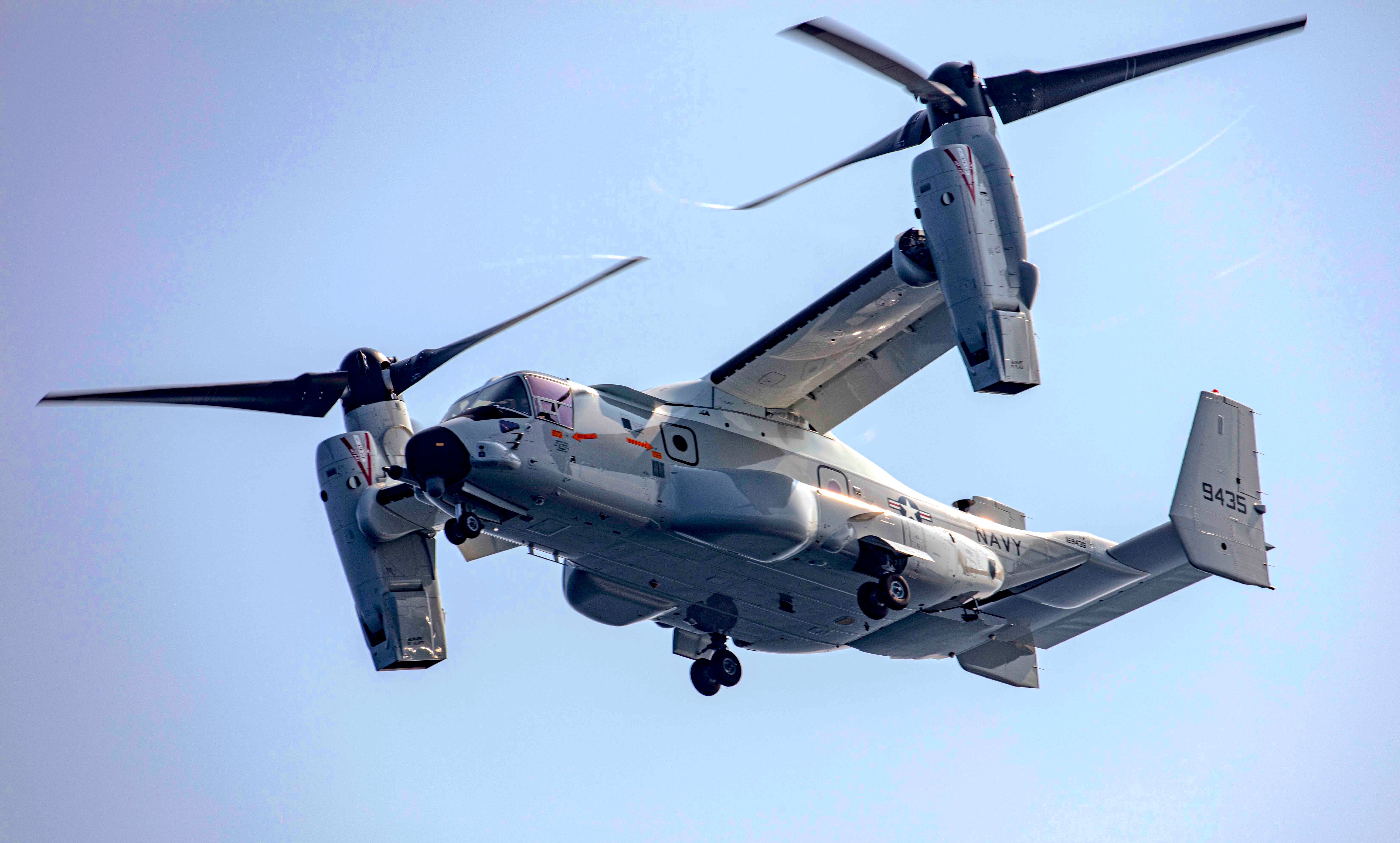
An overseas deployment with Marines is giving some of the Navy’s first crews that will operate its new cargo-delivery fleet of CMV-22B Osprey aircraft hands-on experience with tiltrotor technology and operations.
Ten aircraft maintainers and one naval aviator from Fleet Logistics Multi-Mission Squadron 30 are deployed with Special Purpose Marine Air-Ground Task Force-Crisis-Response-Central Command 20.2, flying, operating and maintaining MV-22B Osprey tiltrotors in the Persian Gulf region.
The Navy is working to have its Osprey ready for a first operational deployment aboard USS Carl Vinson (CVN-70) next year in tandem with the first operational deployment of the F-35C Lighting II Joint Strike Fighter. Last year, the service began integrating VRM-30 personnel with Marine Medium Tiltrotor Squadron 166 (Reinforced) to get them experience with the Osprey and help develop their qualifications and certifications to operate the aircraft.
The Navy will replace its C-2A Greyhound – the backbone of its carrier onboard delivery (COD) fleet since the first models in the mid-1960s – with the slightly larger CMV-22B Osprey, modified from the Marines’ variant to include a public-address system and better lighting for passengers. VRM-30, which is based at Naval Air Station North Island, Calif., received its first CMV-22B in June. The Navy plans to procure 44 aircraft, with initial operational capability in 2021, according to Naval Air Systems Command.
A total of 21 Navy personnel with VRM-30’s “Titans” integrated in late 2019 with VMM-166 at Marine Corps Air Station Miramar in San Diego for follow-on training. Eleven of them volunteered for the SPMAGTF deployment.
“It’s been a seamless integration,” Marine Lt. Col. James “Johnny” Ford, who commands the “Sea Elks” of VMM-166 and SPMAGTF’s air combat element, said by phone from Kuwait. The Special Purpose MAGTF is led by the command element of the 13th Marine Expeditionary Unit and, on the yearlong deployment, serves as the go-to force for U.S. Central Command for quick responses to crises and contingencies in the Middle East, if needed.
“They’re getting a lot of great experience out there,” Ford said of the VRM-30 detachment working mostly from the SPMAGTF’s airbase in Kuwait. In recent months, the sailors have flown and operated MV-22B Ospreys off several ships in the Persian Gulf region, including expeditionary sea base USS Lewis B. Puller (ESB-3).
“We’ve gotten flight experience at all times of the day,” said Naval Aircrewman 2nd Class Jordan Hall. “I got fully qualified for night operations out here, so I can take that forward as well and use that experience to teach my sailors.”
Hall is also one of the first, if not the first, Navy V-22 crew chief to earn his combat aircrew wings, and earned his Fleet Marine Force warfare badge that’s coveted among Marines, Ford said. “We are very proud of him.”
The VRM-30 detachment has a mix of flight experiences. The senior officer is a C-2 Greyhound pilot who’s transitioned to the Osprey. One crew chief flew with a light passenger-and-cargo C-12 unit and several junior sailors are fresh off initial aviation training getting their first operational hands-on experience with the tiltrotor aircraft.
For Hall, the MV-22B is “a totally different aircraft” than Navy helicopters and the C-12 turboprop he’s recently worked with. “Flying is pretty much like a helicopter, not quite an airplane at the same time,” he said of the Osprey. “There’s definitely a few lessons in my previous training, habits that I had to let go of as I got experience and learned more about this aircraft.”
“I’ve taken a lot of the lessons learned and the operational experience out here … back and I’m going to share all of that experience and knowledge” with his VRM-30 squadron mates, he added.
The squadron of Marines and sailors have stayed busy working during the deployment, working a 12 hours on, 12 hours off daily schedule, Ford said, and sailors still were able to attain important certifications and qualifications. “They’ve gained a lot of experience out here, both operationally and in the maintenance side,” he said. “They made two safe-for-flights (qualifications), five collateral duty/quality assurance inspectors, seven collateral-duty inspectors, and then a host of higher qualifications.”
“It’s been mutually-beneficial for them to join us,” he added. “They’ve filled some manpower gaps and directly supported the crisis-response mission.”
Lt. Cmdr. Charles Yeargin, a veteran C-2 pilot also with VRM-30, filled the position of ACE executive officer for about three months “and helped push along the naval integration,” Ford said. They worked together through sorting out some differences such as with naval administration, “but we both learned a lot. It went very well.”
“It’s been a great experience having the sailors with us,” Ford added. “They did everything the Marines did to get ready for the deployment.”





